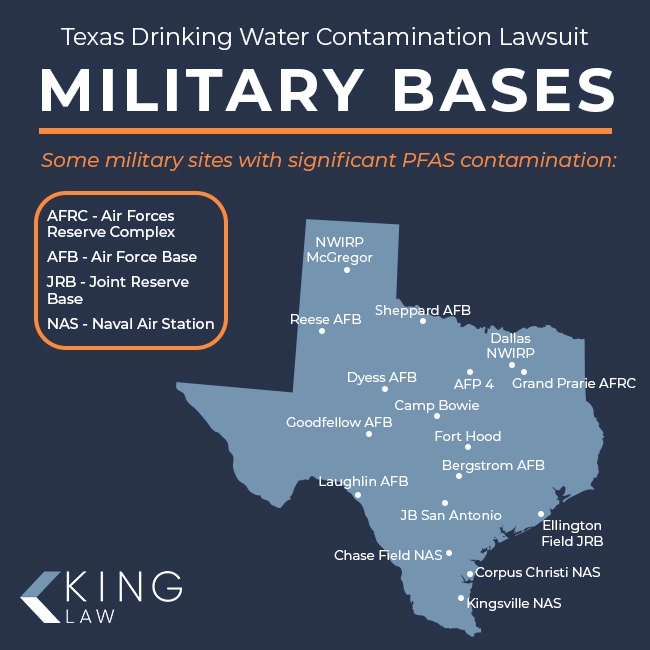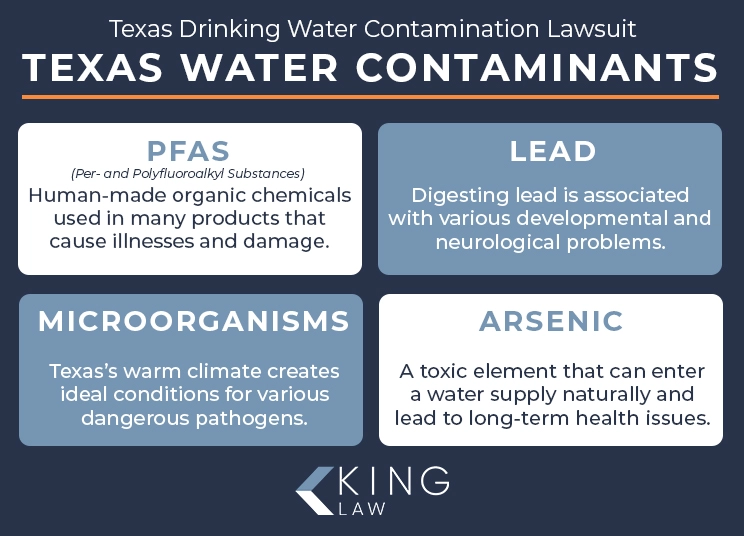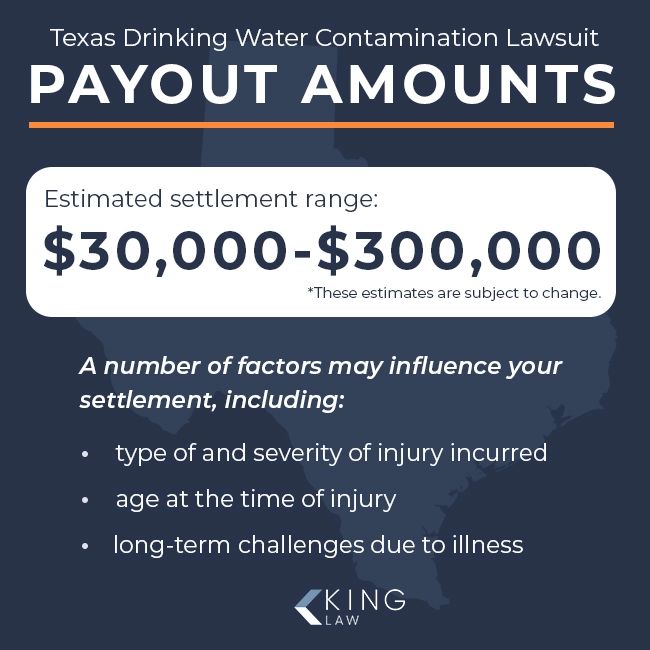See if You Qualify

People are filing lawsuits in Texas after developing serious conditions linked to contaminated water. While longstanding Environmental Protection Agency (EPA) regulations set limits on many toxins that can contaminate drinking water, existing guidelines aren’t always enough to protect people. For example, chemicals called PFAS are known to be dangerous to human health. These chemicals are still present in many drinking supplies in Texas because EPA regulations have been pushed out several years.
Texas residents who suffered injuries like kidney cancer, testicular cancer, or ulcerative colitis, may be able to seek compensation if their water supply was contaminated. The money from a lawsuit can help cover medical bills, lost income, and pain and suffering.
Texas Water Contamination Lawsuit Overview
Texas is the second-largest state in the union by both area and population, playing host to industries like agriculture, oil and gas, and high-tech. It also hosts the second-highest number of military installations in the nation. The presence of military bases leads to a particularly challenging type of water contamination.
Per- and polyfluoroalkyl substances (PFAS) or “forever chemicals,” commonly used at these sites can infiltrate groundwater and surface water and migrate over time. The use of PFAS-contaminated biosolids in Texas agriculture has also been linked to water contamination. Consuming hazardous amounts of these chemicals has been linked to cancer and birth defects, as well as thyroid and intestinal disease. Individuals injured by these chemicals, or their surviving family members, may be eligible to file a lawsuit.
Timeline of Water Contamination in Texas | 2025 Update
July 2025: Texas lawmakers sidestepped several bills that would have helped address the growing PFAS problem in Texas. House Bill 1674, House Bill 1730, House Bill 1145, House Bill 3738, and Senate Bill 1898 all failed to advance to the governor’s desk. These bills sought to address multiple aspects of PFAS contamination, from PFAS in fertilizers, how the chemicals affect human health, PFAS in food supplies, PFAS used in fracking, and the use of PFAS in firefighting foams. Lacking legislative action, some Texas residents are pursuing lawsuits against the companies responsible for polluting water supplies across the state.
June 2025: Farmers in Johnson County Texas are still reeling from a state of disaster over PFAS contamination. In February, county officials declared a state of disaster after discovering dangerously high levels of PFAS in agricultural land, groundwater, and animal tissue. Some PFAS levels were hundreds of times higher than EPA limits. This contamination has been linked to biosolids, which are used as fertilizer. PFAS can easily leach into groundwater in the area, contaminating wells and other water supplies. Community leaders are calling on Governor Greg Abbott to declare an emergency in Johnson County so the county can have access to federal aid.
May 2025: After rolling them back earlier in the year, the EPA announced it would keep proposed regulations that would set PFOS and PFOA limits to 4 ppt (parts per trillion). These guidelines will supersede less stringent state regulations, if any, with initial monitoring beginning in 2027.
March 2025: Fort Worth sues the U.S. Department of Defense, 3M, and DuPont for $420 million in damages for PFAS contamination of the city’s water supply.
February 2025: Johnson County declares a state of disaster after tests show groundwater contamination by PFAS “several hundred times” greater than the EPA’s proposed limits. Substantial contamination was also found in nearby Fort Worth’s wastewater.
April 2024: The EPA proposes the first enforceable federal drinking water limits for PFAS. Most states, including Texas, do not regulate PFAS at the state level.
June 2023: A Natural Resources Defense Council study detects PFAS in some water samples from Houston water supplies.
March 2022: Groundwater at Fort Worth Joint Reserve Base tests positive for PFAS contamination, with concentrations as high as 29,800 ppt.
June 2019: PFAS groundwater contamination exceeding the EPA’s Lifetime Health Advisory Level of 70 ppt is detected in 222 private wells around Reese Air Force Base.
About the Texas Water Contamination Lawsuit
Texas Water Contamination Lawsuit Overview
Timeline of Water Contamination in Texas | 2025 Update
Sources of Water Contamination in Texas
Texas’s Regulations for Drinking Water
Contaminants Found in Texas Drinking Water
Current Water Quality in Texas
Health Risks and Symptoms Linked to Drinking Water in Texas
Eligibility Criteria for the Texas Water Contamination Lawsuit
Texas Water Contamination Settlement and Payout Amounts
How to File a Texas Water Contamination Lawsuit
Statute of Limitations for Texas Water Contamination Claims
Sources of Water Contamination in Texas
Water sources in Texas are vulnerable to water contamination by a number of means. An emerging contaminant is PFAS. One of the more common sources of PFAS contamination is the use of aqueous film-forming foam (AFFF), which was used to fight chemical fires, particularly on military bases and airports.
Texas is also facing contamination by another vector, the use of biosolids from treated sewage as fertilizer. While the sludge is treated to remove other pollutants, a lack of PFAS regulations has allowed PFAS-contaminated sludge to infect soil and agriculture in Texas. Unfortunately, many of the areas that have tested positive for PFAS fall within the state’s populous Texas Triangle, with particularly high concentrations in and around Fort Worth.
Texas also faces frequent issues with E. coli and other microorganisms due to its warm and, in the western parts of the state, arid conditions. Texas has also faced water contamination issues from things like degrading or insufficient infrastructure that can introduce contaminants like lead or copper into drinking water.
Water Contamination From Texas Military Installations
Texas has the second-highest number of military sites in America. While not all installations are equally contaminated, these sites are frequently the source of PFAS in groundwater, soil, and nearby surface waters.
Military bases in Texas: Dyess AFB, Fort Bliss, Fort Cavazos, Goodfellow AFB, Joint Base San Antonio, Laughlin AFB, Naval Air Station Corpus Christi, Naval Air Station Joint Reserve Base Fort Worth, Naval Air Station Kingsville, Red River Army Depot, Sheppard AFB, US Army Cadet Command 5th Brigade, USAREC- 5th Medical Recruiting Battalion, USAREC-Dallas Battalion, USAREC-Houston Battalion, USAREC-San Antonio Battalion, 136 AW, 147 ATKW, 149 FW
Some significant PFAS test results at locations in Texas include:
- Grand Prairie Armed Forces Reserve Complex (2018): 1,247,000 ppt combined for PFOA and PFOS
- NWIRP McGregor (2022): 240 ppt for PFOA and PFOS
- Reese Air Force Base (2018): 5,633 ppt for PFOA and PFOS
- Goodfellow Air Force Base (2017): 124,000 ppt for PFOA and PFOS
- Laughlin Air Force Base (2018): 27,300 ppt for PFOA and PFOS
- Dyess Air Force Base (2017): 448,200 ppt for PFOA and PFOS
- Sheppard Air Force Base (2019): 650,000 ppt for PFOA and PFOS
- Joint Base San Antonio (2017–2018): 756,000 ppt for PFOA and PFOS
- AFP 4 (2019): 201,200 ppt for PFOA and PFOS
- Bergstrom Air Force Base (2018): 9,970 for PFOA and PFOS
- Kingsville NAS (2022): 733,000 ppt for PFOA and PFOS
- Ellington Field Joint Reserve Base (2018): 61,000 ppt for PFOA and PFOS

Texas’s Regulations for Drinking Water
Texas’s drinking water regulations are set mainly by the federal EPA. The Texas Commission on Environmental Quality does track several contaminants and conducts sampling of drinking water.
Regulations for various contaminants include:
- PFAS: Texas did not set its own PFAS regulations ahead of the EPA, but will abide by EPA standards. However, it uses the same regulations as the EPA for PFAS in drinking water supplies in Texas. However, these regulations do not go into effect for several years. That means Texas will have until 2027 to set up PFAS monitoring and 2029 to address violations. The EPA sets an MCL of 4 ppt for PFOA and PFOS.
- Lead: Federal regulations for lead require action at an MCL of 15 ppb.
- Copper: The EPA action level for copper contamination is 1.3 ppm.
- Radionuclides: Radioactive materials can enter water both naturally and as a byproduct from nuclear facilities. The MCL for uranium, for example, is 30 ppb.
- Disinfectants and Disinfectant Chemicals: This category includes both disinfectant chemicals and their byproducts, such as chlorine and chloroform. These are governed by the EPA’s Stage 1 and Stage 2 Disinfectants and Disinfection Byproducts Rules.
- Arsenic: The EPA sets an MCL of 10 ppb for arsenic.
- Microbial Organisms: This includes a variety of tiny microorganisms, like bacteria and protozoa, that can potentially cause illness when consumed. Regulations vary by pathogen, with some even set at zero. Immunocompromised individuals may have a lower tolerance for the contaminants.
Texas Water Contamination Map
Texas’s water contamination tends to track closely to highly populated areas, including the three points of the Texas Triangle. Other sites are scattered across the state, often in proximity to military sites. Contamination levels of sites can vary over time as pollutants are transported from the area by the natural flow of water or are cleaned up through human intervention.
Contaminants Found in Texas Drinking Water
PFAS and other manmade contaminants can find their way into drinking water despite regulatory oversight. Meanwhile, the degradation of water lines can introduce lead or copper into tap water at a building-by-building level. All of these contaminants can have serious impacts on health, particularly for children.
Per- and Polyfluoroalkyl Substances (PFAS)
Per- and poly-fluoroalkyl substances (PFAS), a class of thousands of synthetic organic chemicals, are used in products ranging from firefighting foam to food wrappers, clothing, and cookware. They’re known for their strong chemical bonds, which make these chemicals hard to break down, and for their ability to repel water. Recent research, however, has found PFAS in drinking water, soil, and blood samples from animals and humans. These persistent chemicals can accumulate, causing damage to people, ecosystems, and livestock.
PFOS and PFOA are two of the more well-known toxic PFAS, though more have been identified as dangerous or as substances of concern. Texas is not expected to have widespread PFAS regulations in place until 2027, with action coming as late as 2029. Some affected municipalities, like Fort Worth, are being forced to take action earlier.
Lead
Lead poisoning is associated with developmental problems, neurological issues, and kidney damage. Although lead has been regulated federally since the 1990s, aging water systems can introduce lead into drinking water en route to the tap, even if the water source is not contaminated. Replacing out-of-date piping is a major front in the fight against lead in drinking water.
Microorganisms
Texas’s warm climate and frequent droughts can create ideal conditions for microorganisms to thrive in, including rare but dangerous pathogens like Naegleria fowleri, a brain-eating amoeba, which can enter through the sinuses. E. coli, a bacterium that can cause diarrhea, vomiting, and fever, is a frequent nuisance around Texas and can enter water systems through agricultural runoff or flooding. Boil-notices and other warnings are often put into effect when microorganism contamination occurs in water supplies.
Arsenic
Arsenic is a toxic element that can naturally enter water supplies through mineral erosion or through industrial and agricultural waste. Arsenic is deadly in high concentrations, but exposure to smaller amounts over the long term can lead to skin conditions, high blood pressure, and an increased risk of cancer.

Current Water Quality in Texas
Texas’s water quality varies from area to area, but the Lone Star State often fares poorly in comparative studies between states. Some of this is growing pains as Texas’s population booms and industries and agriculture take advantage of its low-regulation environment. The state has also inconsistently enforced regulations, particularly in more rural areas. Urban areas are not immune either, with Fort Worth in particular dealing with the fallout of PFAS contamination.
The EPA estimates that around 50 public drinking water systems in Texas contain PFAS in amounts that exceed federal guidelines. The state expects to have initial monitoring of PFAS chemicals in drinking in place by April 2027.
Water Treatment Efforts in Texas
Fort Worth is researching systems to remove PFAS from its drinking water, though any actionable solutions are expected to be quite costly. Statewide bills aimed at curtailing PFAS in firefighting foam and fertilizers have failed thus far.
Health Risks and Symptoms Linked to Drinking Water in Texas
The dangers of PFAS contamination in drinking water are a growing concern in every state, including Texas. Many veterans and those who have lived on or near military bases have consumed contaminated water and suffered serious health conditions. Many civilians have also developed diseases related to concentrations of PFAS far exceeding EPA guidelines.
Exposure to unsafe levels of these chemicals is linked to:
- Birth defects
- Bladder cancer
- Breast cancer
- Changes in liver enzymes
- Decreased vaccine effectiveness
- Hodgkin’s and non-Hodgkin’s lymphoma
- Leukemia
- Lowered immune response
- Multiple-myeloma
- Kidney cancer
- Liver cancer
- Pancreatic cancer
- Prostate cancer
- Reproductive issues
- Testicular cancer
- Thyroid cancer
- Thyroid disease
- Ulcerative colitis
These conditions can permanently affect an individual’s quality of life and, in some cases, may even be deadly.
Eligibility Criteria for the Texas Water Contamination Lawsuit
To be eligible for a water contamination lawsuit in Texas, you need to meet the following prerequisites:
Duration of Exposure: Eligible individuals will have lived, worked, or been deployed in a contaminated area of Texas for at least 6 to 12 months.
Necessary Diagnoses: King Law is evaluating cases with a diagnosis of:
Supporting Documents: Supporting documents serve as evidence for water contamination cases. Records that establish a qualifying medical diagnosis, as well as those that establish a presence in the contaminated area, are critical for building a strong claim. Individuals should consult with an attorney to make sure they know what documents to collect.
Texas Water Contamination Settlement and Payout Amounts
Many water contamination settlements will pay out between $30,000 and $300,000. Individuals who have suffered more serious injuries are more likely to receive a large reward than people who have sustained minor injuries. An attorney can evaluate your claim in advance to give you more accurate expectations.

How to File a Texas Water Contamination Lawsuit
If you think you’ve been exposed to contaminated water in Texas, and you have a qualifying diagnosis, you’ll want to pursue your claim as quickly as possible:
- Consultation: Speaking with an attorney can help set expectations for your claim and help you set a roadmap for the remainder of the process.
- Collect Evidence: You will need to collect relevant documentation to strengthen your claim. Look for documents that can place you at the site of water contamination through residence or work. Provide relevant medical records that show you have an injury related to water contamination. You will also want to find environmental studies that show the water supply in your place of work or residence was contaminated at the time you were there.
- Filing: Your attorney will draft and submit the necessary documentation within Texas’s statute of limitations. Your attorney will help you decide the most advantageous jurisdiction to file your case in.
- Pre-Trial Procedures: At this stage, both sides will exchange evidence and depositions, conducting interrogations where necessary.
- Settlement: Your attorney will attempt to reach a settlement with the defense. If they are successful, you will receive a negotiated payout.
- Trial: If a settlement can’t be reached, your case will go to trial. A judge or jury will decide what, if any, damages are awarded.
Evidence to Support Your TX Water Contamination Claim:
There are two main categories of evidence you will need to support your water contamination claim. The first is evidence that establishes your presence in a contaminated area. This includes scientific or academic papers that show dangerous levels of contamination within a specific timeframe. You also need to show that you lived or worked within that area. For that, you’ll want to collect utility bills, leases, mortgage agreements, or employment-related documents. Your attorney will help gather scientific evidence.
The other category involves showing that you suffered damages from your exposure to water contamination. To do this, you’ll want to collect medical records, medical bills, and testimonies that link your condition to your exposure.
Statute of Limitations for Texas Water Contamination Claims
In most cases, water contamination claims in Texas must be filed within a two-year window from the date of the injury. This is referred to as the statute of limitations. However, when that window begins or if it can be extended is not always obvious. For example, if you did not know your condition was caused by PFAS exposure, you may have additional time to file a PFAS claim. You should consult with a qualified attorney to know if you are currently within the statute of limitations to file a water contamination lawsuit in Texas.
Texas Water Contamination Lawyers
Working with a lawyer who is experienced in personal injury or environmental law can help evaluate your case, set expectations, and reach a settlement. Contact us today for a free consultation with no obligations. Our firm works on a contingency-fee basis, meaning you do not pay us unless we recover money for your injuries.
Frequently Asked Questions (FAQs)
Learn more about water contamination in Texas with answers to these frequently asked questions:

